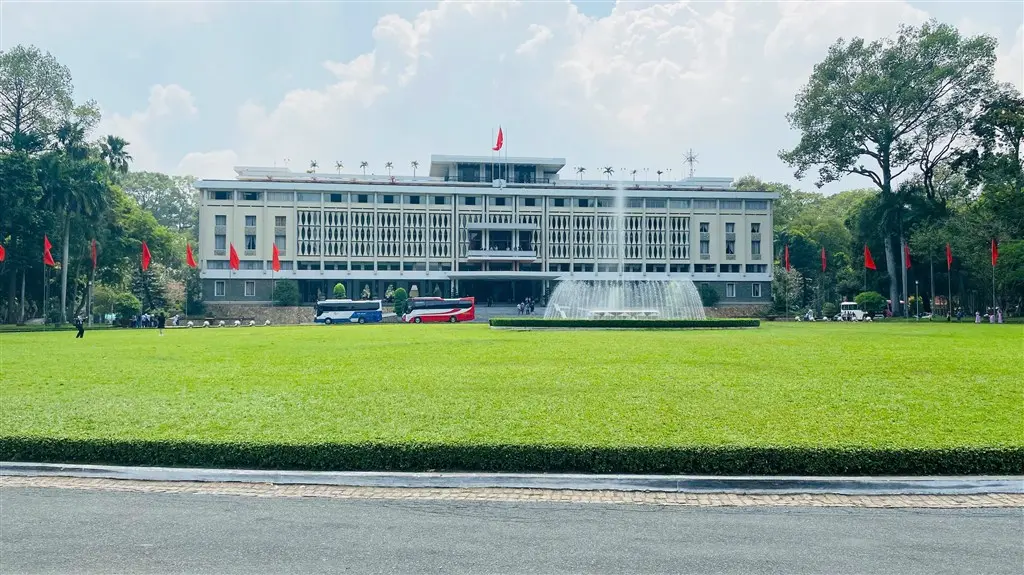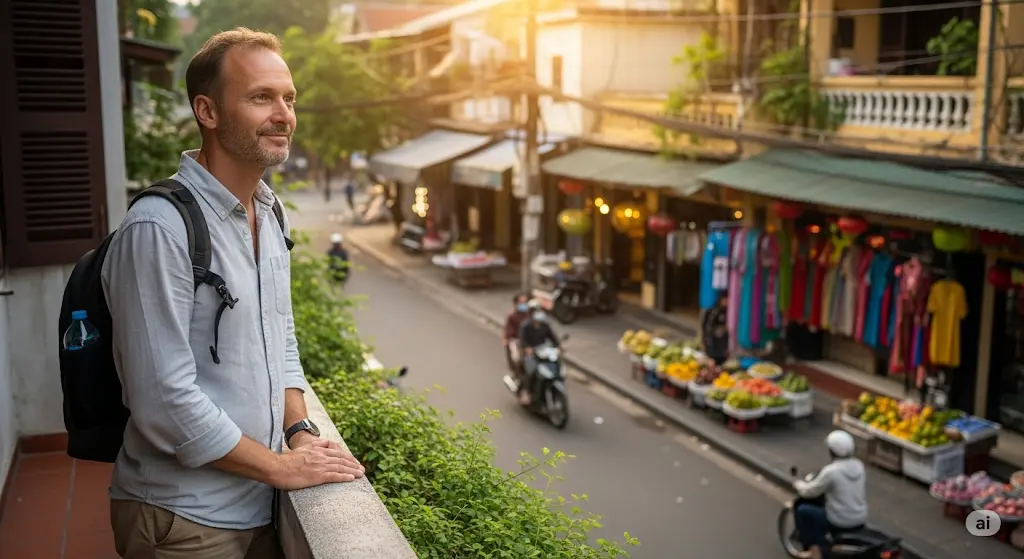Vietnam offers a culinary journey unlike any other. EssentialVietnamtravel.com understands the quest for authentic tastes. This guide explores the best food of vietnam, a vibrant tapestry woven from fresh ingredients, regional traditions, and centuries of history. Forget bland descriptions; prepare for an exploration of flavors that define a nation. From steaming Phở bowls in Hanoi to sizzling street food in Ho Chi Minh City, eat in vietnam is an adventure for the senses.
Finding the best food in vietnam isn’t just about famous dishes; it’s about understanding the culture. Vietnamese cuisine prioritizes balance – the interplay of sweet, sour, salty, bitter, and umami. Fresh herbs are not mere garnish; they are integral components. This focus on freshness and balance makes foods in vietnam both delicious and often quite healthy. Whether you’re a seasoned traveler or planning your first trip, discovering the popular food in vietnam is essential. This guide provides clear, practical steps to navigate this delicious landscape.
The Heartbeat of Vietnamese Cuisine: Why It Captivates
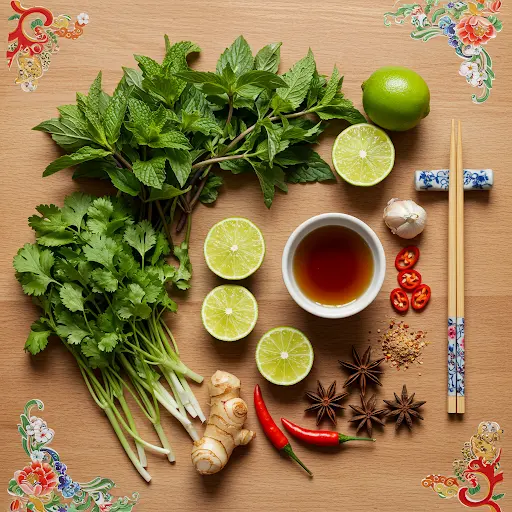
Vietnamese cuisine stands distinct within Southeast Asian cuisine. Its identity is shaped by geography, history, and a deep respect for ingredients. Unlike some neighbouring cuisines known for overwhelming spice, Vietnamese cooking often emphasizes subtlety and the harmonious blend of flavors. The country’s long coastline provides abundant seafood, while fertile deltas yield rice and fresh produce.
A core principle is the “Wu Xing” or five-element philosophy, applied to taste. Every dish strives for a balance of five flavors: spicy (metal), sour (wood), bitter (fire), salty (water), and sweet (earth). This balance creates complexity without being overwhelming. Think of the dipping sauce nuoc cham – a ubiquitous condiment perfectly balancing fish sauce (salty/umami), lime juice (sour), sugar (sweet), chili (spicy), and sometimes garlic. It’s a microcosm of the cuisine’s philosophy.
Freshness is paramount. Markets overflow with vibrant greens, herbs like mint, cilantro, basil, and perilla. These aren’t just added at the end; they’re often served in large bunches alongside dishes like Bun Cha or Banh Xeo, allowing diners to customize each bite. This makes foods of vietnam incredibly flavorful and aromatic.
French colonial history left an indelible mark, most notably with the baguette, leading to the creation of the iconic Banh Mi sandwich. Coffee culture also blossomed, resulting in the unique Vietnamese Coffee prepared with a phin filter. Yet, despite these influences, the cuisine remains deeply Vietnamese, absorbing foreign elements and making them distinctly its own. Understanding these foundations helps you appreciate why searching for the best vietnam food is such a rewarding experience. It’s more than just sustenance; it’s a cultural immersion. Travel Experiences in Vietnam are often centered around food discoveries.
Iconic Dishes: Your Must-Try Checklist for the Best Food of Vietnam
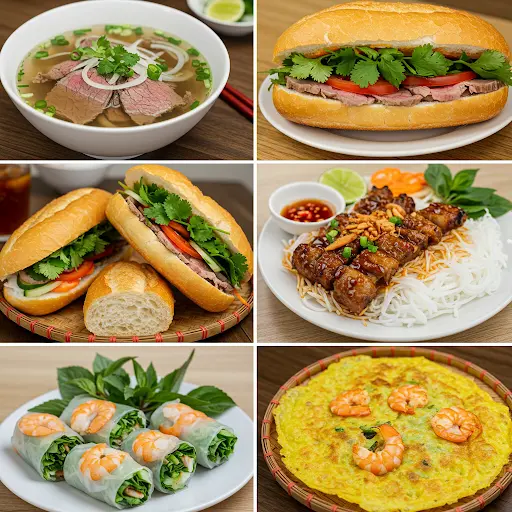
Navigating the vast array of Vietnamese dishes can be daunting. EssentialVietnamtravel.com recommends starting with the icons – the dishes that represent the soul of Vietnamese cooking. These are often the most popular food in vietnam for good reason.
Pho: The National Soup Soul
No discussion of the best food of vietnam is complete without Pho. This seemingly simple noodle soup is a universe of flavor. Pho is fundamentally rice noodles in a savory broth, served with meat (usually beef or chicken) and a plate of fresh herbs. But the magic lies in the broth. Pho Bo (beef pho) broth is simmered for hours with bones, charred ginger, onion, star anise, cinnamon, and other spices, creating a complex, aromatic base. Pho Ga (chicken pho) offers a lighter but equally flavorful alternative.
- Regional Styles: Pho originated in North Vietnam. Hanoi-style Pho is often simpler, emphasizing the pure taste of the broth. Southern-style Pho, found commonly in Ho Chi Minh City, tends to be slightly sweeter and served with more abundant garnishes like bean sprouts, culantro, Thai basil, and lime wedges.
- How to Eat It: Add herbs, sprouts, and chili to your liking. A squeeze of lime brightens the flavors. Use Chopsticks to handle the noodles and meat, and a spoon for the broth. Finding the best pho in Hanoi old quarter is a popular quest. It’s more than a dish; it’s a breakfast ritual, a comforting lunch, a late-night cure-all. It truly represents vietnamese food in vietnam.
Banh Mi: A Symphony in a Sandwich
The Banh Mi sandwich is a perfect example of French-Vietnamese fusion and a strong contender for the best food in vietnam. The foundation is a light, airy baguette with a thin, crisp crust – a legacy of French colonial influence (Banh Mi, Origin Influence, French). Inside, it’s a party of textures and tastes.
- Common Fillings: Fillings vary widely but often include pâté, various Vietnamese cold cuts (cha lua), grilled pork (Bun Cha, Main Ingredient, Grilled Pork – though Bun Cha is a different dish, grilled pork is also popular in Banh Mi), pickled carrots and daikon (do chua), fresh cilantro, cucumber, and often a smear of mayonnaise or chili sauce.
- Where to Find It: Banh Mi stalls are ubiquitous, from cities like Ho Chi Minh City to small towns. Look for vendors with fresh ingredients and a steady stream of customers. Affordable best food of vietnam ho chi minh city often includes finding a fantastic Banh Mi stall. It’s a quick, satisfying, and incredibly good food in vietnam.
Bun Cha: Hanoi’s Grilled Pork Delight
If you’re in Hanoi, seeking out Bun Cha is non-negotiable. This dish famously shared by President Obama and Anthony Bourdain captures the essence of Northern Vietnamese flavor. It features smoky, grilled pork patties and pork belly slices served in a bowl of diluted, slightly sweet and sour Nuoc Mam (fish sauce) dipping sauce, typically containing pickled green papaya and carrots.
- The Experience: Alongside the pork and sauce comes a plate of fresh rice vermicelli noodles (bun) and a basket overflowing with fresh herbs and lettuce.
- How to Eat It: You dip the noodles and herbs into the sauce with the pork, creating a personalized, perfect bite each time. The combination of smoky meat, tangy sauce, fresh noodles, and vibrant herbs is unforgettable. Bun Cha Hanoi is a quintessential Hanoi experience and a must-try when exploring where to eat in vietnam, especially in the capital. This dish uses Nuoc Mam, Type, Fish Sauce as a critical base for its dipping sauce.
Goi Cuon & Nem Ran: Rolls of Freshness and Crunch
Goi Cuon (fresh spring rolls or summer rolls) showcase the emphasis on fresh ingredients. Delicate Rice Paper wrappers (Goi Cuon, Wrapper, Rice Paper) encase cooked shrimp, pork slices, rice vermicelli, lettuce, and plenty of fresh herbs like mint (Vietnamese Herbs, Common Type, Mint). They are served cool, usually with a peanut-based dipping sauce or nuoc cham. These are light, healthy, and incredibly refreshing.
- The Fried Counterpart: Nem Ran (in the North) or Cha Gio (in the South) are the fried cousins (Nem Ran, Type, Fried Spring Roll). These crispy rolls typically contain minced pork, shrimp, mushrooms, glass noodles, and vegetables. They are served hot and crunchy, often with lettuce and herbs for wrapping, and a nuoc cham dipping sauce. Both roll types are popular foods in vietnam and offer contrasting textures.
Banh Xeo: The Sizzling Crispy Crepe
Often called a Vietnamese crepe or pancake, Banh Xeo is a unique delight. The name means “sizzling cake,” referring to the sound the rice batter makes when poured into the hot skillet. The batter is typically made with rice flour, coconut milk, and turmeric (giving it a yellow hue). It’s pan-fried until incredibly crispy (Banh Xeo, Texture, Crispy) and filled with pork, shrimp, onions, and bean sprouts.
- Serving Style: Banh Xeo is usually served with a generous platter of lettuce and fresh herbs.
- How to Eat It: Tear off a piece of the crepe, wrap it in lettuce and herbs, and dip it into nuoc cham. The contrast between the hot, crispy crepe, the savory filling, and the cool, fresh greens is exceptional. It’s a fun, interactive dish and a fantastic example of good food in vietnam.
The Soul of the Streets: Exploring Vietnam’s Street Food Culture
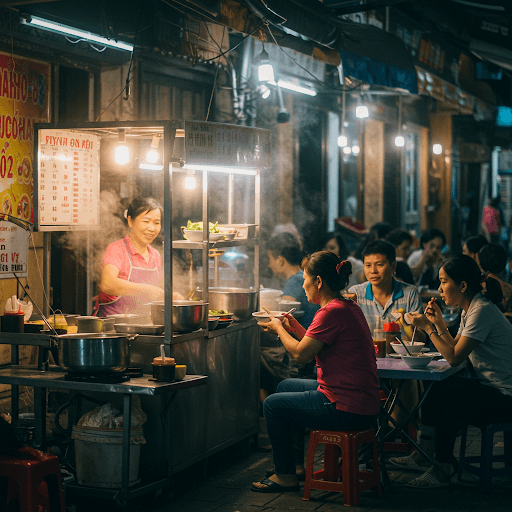
No exploration of the best food of vietnam is complete without diving into its legendary street food scene. Vietnam eat often happens curbside, perched on tiny Plastic stools (Street Dining, Seating, Plastic Stools), savoring dishes cooked mere feet away. Exploring best food of vietnam street stalls is an essential part of any culinary trip.
The Street food stall is the heart of daily life and culinary innovation. From makeshift stands to more permanent shop-houses opening onto the pavement, this is where you’ll find many popular food in vietnam served quickly, affordably, and often, exceptionally well. Hanoi Old Quarter and markets like Ben Thanh Market in Ho Chi Minh City are hotspots, but delicious finds await on almost any street.
What makes Vietnamese street food special?
- Specialization: Many vendors focus on mastering just one or two dishes, passing down recipes through generations. The stall selling Pho likely only sells Pho. The Banh Mi vendor focuses solely on sandwiches. This dedication leads to incredible quality.
- Freshness: Ingredients are often bought fresh from the market daily (Street Food, Key Feature, Freshness). Limited storage space means high turnover and ingredients that haven’t been sitting around.
- Visibility: You can often see the food being prepared right in front of you, adding to the experience and offering some reassurance about hygiene.
- Atmosphere: Eating street food is an immersive experience. The sounds, smells, and energy of the street become part of the meal. It’s communal dining at its most vibrant.
Beyond the iconic dishes already mentioned, street stalls offer countless other treasures: Com Tam (Main Ingredient, Broken Rice), various noodle soups (Hu Tieu, Bun Bo Hue), savory steamed rice cakes (Banh Beo, Banh Bot Loc), sweet soups (Che), and grilled skewers. Where to eat in vietnam often means simply following your nose or looking for a crowd. A key indicator of a good street stall is a busy crowd (Street Stall, Indicator, Busy Crowd). Locals know best, and a busy stall usually signifies quality and safety.
A Tale of Three Regions: Understanding Vietnamese Food Variations
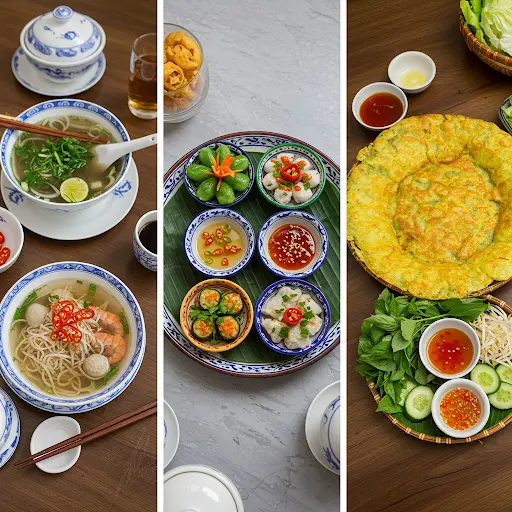
Vietnam’s diverse geography shapes its cuisine, creating distinct regional variations. Understanding these differences enhances your appreciation for the foods of vietnam.
Northern Cuisine (Hanoi & Surrounds): Subtle & Balanced
- Characteristics: Generally less spicy and sweet than other regions. Flavors are often subtle, balanced, and refined, focusing on the inherent taste of fresh ingredients. Black pepper is favored over chili for heat.
- Iconic Dishes: Pho (especially Pho Bo with clear broth), Bun Cha Hanoi, Cha Ca La Vong (turmeric fish with dill), Nem Ran (fried spring rolls). The emphasis is on umami and clean flavors.
Central Cuisine (Hue, Hoi An, Da Nang): Spicy & Royal
- Characteristics: Known for being the spiciest region. Hue, the former imperial capital, boasts a sophisticated Hue Imperial Cuisine (Characteristic, Royal Influence) featuring many small, intricate dishes (‘banh’ varieties). Flavors are bold and complex.
- Iconic Dishes: Bun Bo Hue (spicy beef noodle soup), Cao Lau (Origin City, Hoi An – unique noodles found only here), Mi Quang (turmeric noodles), Banh Beo, Banh Nam, Banh Bot Loc (various steamed rice cakes). This region offers some of the most famous food in vietnam known for presentation.
Southern Cuisine (Ho Chi Minh City & Mekong Delta): Sweet & Herby
- Characteristics: Tends towards sweeter flavors, influenced by warmer climate and Cambodian/Thai proximity. Generous use of sugar, coconut milk, and a wider variety of fresh herbs (Fresh Herbs, Role, Garnish). More liberal use of chilies compared to the North.
- Iconic Dishes: Southern-style Pho (sweeter broth, more garnishes), Com Tam (broken rice with grilled pork), Banh Xeo (often larger and crispier here), Hu Tieu Nam Vang (pork and seafood noodle soup), Ca Kho To (caramelized fish in clay pot). The Mekong Delta provides abundant tropical fruits and freshwater fish.
Knowing these regional tendencies helps you understand what to eat in vietnam depending on your location and appreciate the hyperlocal specialization that makes Vietnamese food so diverse.
Beyond the Plate: Essential Vietnamese Drinks
Your culinary adventure in Vietnam extends beyond solid food. The drinks culture is equally fascinating and integral to the experience.
Ca Phe: The Coffee Ritual
Vietnamese Coffee is world-renowned, primarily using strong Robusta Beans. The classic preparation involves a phin filter (Vietnamese Coffee, Brewer, Phin Filter), a small metal drip filter placed over a glass. Hot water is added, and the dark, intense coffee slowly drips through.
- Ca Phe Sua Da: The most popular version is iced coffee with sweetened condensed milk (Key Ingredient, Condensed Milk). The strong coffee mixed with the sweet, creamy milk, served over ice, is a perfect antidote to the tropical heat.
- Ca Phe Den Da: Iced black coffee.
- Coconut Coffee & Egg Coffee: Creative variations like coffee blended with frozen coconut milk or topped with a sweet, frothy egg yolk mixture (originating in Hanoi) are also must-tries.
Nuoc Mia: Refreshing Sugarcane Juice
Found at street carts everywhere, Nuoc Mia (Base Ingredient, Sugarcane) is fresh sugarcane juice. Stalks of sugarcane are pressed through a machine, often with a small citrus fruit like kumquat added for tanginess. It’s incredibly refreshing, naturally sweet, and a cheap, hydrating drink.
Bia Hoi: Fresh Local Beer
Bia Hoi refers to fresh, locally brewed draft beer with low alcohol content. It’s incredibly inexpensive and a social staple, often enjoyed at simple street-side bars, served alongside snacks. It’s a unique cultural experience, perfect for winding down after a day of exploring.
Practical Guide: How to Find and Enjoy the Best Food of Vietnam
Now that you’re acquainted with the highlights, here’s how to navigate the culinary scene like a pro. EssentialVietNamtravel provides these steps for an authentic experience.
Finding the Best Spots: Where to Eat
- Look for Crowds: As mentioned, busy stalls and restaurants (Busy stalls indicate popularity) filled with locals are usually your best bet. This is often the simplest answer to “where to eat in vietnam”.
- Ask Locals: Hotel staff, tour guides, or even friendly locals are often happy to recommend their favorite spots for specific dishes. Don’t hesitate to ask, “Where can I find the best Pho near here?”
- Food Tours: Taking a guided food tour (Benefit, Local Insight) is an excellent way to discover hidden gems and learn about the food from an expert. Many tours focus specifically on street food. You can find tours focused on where to find best food of vietnam hanoi or Ho Chi Minh City.
- Markets: Local markets are treasure troves for authentic eats, from fresh produce to ready-to-eat snacks and meals. Ben Thanh Market is famous, but smaller neighbourhood markets are often more authentic.
- Specialty Streets: Some streets become known for a particular dish. Ask around if there’s a ‘Pho street’ or ‘Banh Mi alley’ nearby.
Ordering and Etiquette: Eating Like a Local
- Point and Smile: Don’t worry if you don’t speak Vietnamese. Pointing at the dish you want (either on a menu, picture, or what someone else is eating) combined with a smile usually works perfectly.
- Use Chopsticks: Most meals involve Chopsticks. If you’re unsure how to use them, watch others or ask politely for a fork (though chopsticks are preferred).
- Condiments are Key: Don’t be shy about using the condiments provided – chili sauce, pickled garlic or chili, fresh lime, fish sauce (Nuoc Mam, Taste Profile, Salty Umami). They are meant to enhance and personalize the dish.
- Sharing: Family-style eating is common, especially with dishes like hotpot or platters of grilled food and spring rolls.
- Payment: Street food is usually paid for immediately after receiving the food. In restaurants, you typically pay at the counter or signal for the bill. Tipping is not generally expected but is appreciated for excellent service.
Food Safety: Eating Smart
Concerns about food safety are valid when travelling. While Vietnam’s street food is largely safe and enjoyed by millions daily, exercising caution is wise, especially for sensitive stomachs. This is crucial YMYL (Your Money or Your Life) information.
- Choose Busy Stalls: (Food Safety, Recommendation, Choose Busy Stalls) High turnover means fresher ingredients and less time for food to sit around. This is the single most important tip. Prioritize stalls bustling with local customers.
- Watch the Preparation: Opt for food cooked to order in front of you, served piping hot. Avoid food that looks like it has been sitting out for a long time, especially meat or seafood.
- Peel Fruit: Stick to fruits you can peel yourself (bananas, mangoes, oranges) or that are peeled/cut in front of you. Avoid pre-cut fruit platters that may have been sitting out.
- Bottled Water: Drink only sealed, bottled water. Avoid tap water and ice unless you are certain it’s made from purified water (most tourist-oriented restaurants and hotels use purified ice).
- Trust Your Instincts: If a place looks unclean or something smells off, move on. There are plenty of other options. Don’t risk eating unsafe food or poorly prepared meals. While the worst food of Vietnam is subjective, prioritize safety over adventurousness if unsure.
Following these simple guidelines allows you to confidently explore the best food of vietnam while minimizing risks.
Bringing Vietnam Home: Recipes and Resources
Inspired by the flavorful, fresh, and balanced tastes of Vietnamese cuisine? You might want to recreate the magic at home.
- Finding Recipes: Many websites and cookbooks offer authentic Vietnamese recipes. Look for resources that explain techniques and ingredient substitutions if needed. Searching for “recipe for best food of vietnam pho” is a good starting point.
- Online Cooking Classes: Virtual classes can provide step-by-step guidance from experienced chefs.
- Asian Markets: If you live near an Asian grocery store, you can often find key Vietnamese ingredients like fish sauce (Nuoc Mam Phan Thiet is a famous type), rice paper, vermicelli noodles, and sometimes even fresh herbs.
While nothing beats eating vietnamese food in vietnam, cooking these dishes yourself is a rewarding way to keep the delicious memories alive. It can also be a thoughtful way to answer the question “what food to have for a vietnamese house guest” – preparing a familiar taste of home.
Further Reading: Dive Deeper into Vietnamese Cuisine
- 21 Must-Try Vietnamese Dishes Beyond This Guide (`https://vietnam.travel/things-to-do/21-must-try-vietnamese-dishes`)
- A Foodie’s Guide to Vietnam by Region (`https://vietnam.travel/things-to-do/vietnam-foodie-guide-region`)
- Exploring the Wonderful World of Vietnamese Noodles (`https://vietnam.travel/things-to-do/noodles-of-vietnam`)
- Delicious Vietnamese Snacks You Can’t Miss (`https://vietnam.travel/things-to-do/vietnamese-snacks`)
- 15 Dreamy Desserts to Try in Vietnam (`https://vietnam.travel/things-to-do/15-dreamy-desserts-try-vietnam`)
- All About Vietnam’s Mooncakes (Seasonal Delight) (`https://vietnam.travel/things-to-do/all-about-vietnams-mooncake`
Conclusion: Your Vietnamese Food Adventure Awaits
The best food of vietnam is more than just a list of dishes; it’s an invitation to explore a rich culture, engage your senses, and create unforgettable Travel Experiences. From the delicate balance of flavors in a bowl of Pho to the satisfying crunch of a Banh Mi sandwich enjoyed on a bustling street corner, foods in vietnam offer something for everyone.
EssentialVietnamtravel encourages you to embrace the adventure. Use this guide as your starting point. Be curious, be observant, and most importantly, be hungry. Look for the busy stalls, try the regional specialties, sip the strong coffee, and don’t be afraid to use those Chopsticks. Eat in vietnam is a journey of discovery, a delicious exploration of freshness, flavor, and tradition. The famous food in vietnam is waiting for you. Plan your trip, explore the streets, and discover your own personal “best food of vietnam.”
Ready to Taste Vietnam?
Start planning your unforgettable culinary adventure today. Find the best flight deals and begin your journey!
Compare prices from various airlines with WayAway.

